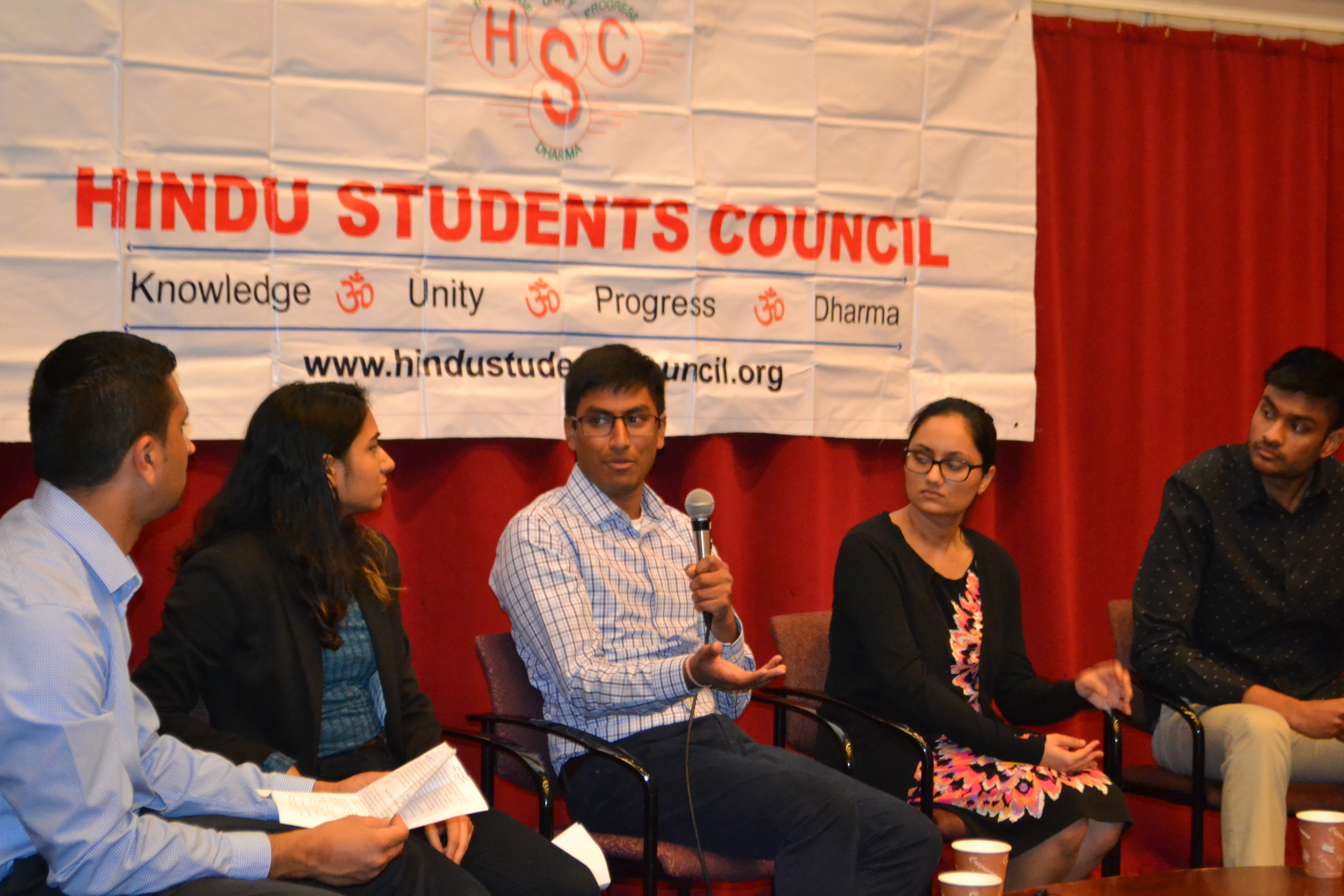Photo Attachment 1: Student panel on Hindu identity and practices
Photo Attachment 2: Dr. Alok Kumar on ancient Hindus and their impact on world
FOR IMMEDIATE RELEASE
For more information, please contact
Nikunj Trivedi at info@hindustudentscouncil.org or 732-800-0081
Second Drishti Collegiate Conference Explores Hindu Identity And The Impact Of Hindu Scientific Achievements On World Cultures Saturday, February 24th. New York. “Hindus are seekers of truth,” remarked Maitreyee Kale, president of Hindu Students Council’s (HSC) chapter at Stony Brook University, as she kicked off a panel discussion on Hindu identity. These words captured the general theme of the conference as it explored the meaning of being a Hindu, misconceptions about Hindu identity as well as the remarkable impacts of
Hindu scientific discoveries on world cultures.
Students from New York University and Stony Brook University, along with members of the HSC National Team engaged in a lively interaction on Hindu practices, traditions and texts that are most appealing to today’s Hindu youth. The panelists shared their experiences of growing up in a western society and how they managed to balance their Hindu and non-Hindu identities while staying rooted in their cultural ethos. They also interacted with conference participants on questions such as how to handle common misconceptions about Hinduism, how to positively engage with non-Hindus to explain Hindu practices and symbols, how concepts such as yoga and Ayurveda are important Hindu contributions, and many other topics.
“I’d never seen a stage where people my age could weigh in on some of the most pressing topics facing Hinduism today,” shared Kavindra Sahabir, an attendee from Stony Brook University. “I was also impressed with the members of the panel and the way they carried themselves throughout the conference.”
Sai Chaluvadi, a panelist and co-president of the HSC chapter at NYU also added: “Learning from their perspectives helped me view various components of the religion differently, broadening my understanding and making me aware of certain issues that Hindus face.”
Dr. Alok Kumar, Distinguished Teaching Professor of Physics at SUNY Oswego and the author of
“Sciences of Ancient Hindus” delivered the conference keynote address. Utilizing years of research and quoting numerous non-Hindu literary sources, Professor Kumar told a fascinating story of how medieval Muslim and Europeans scholars and writers openly acknowledged and credited several important mathematical achievements to ancient Hindus. Unfortunately, today’s math and science classes fail to tell this important story for the benefit of today’s students and to promote multicultural harmony. For example, Sa’id Al Andalusi, a famous Eleventh Century Muslim judge and philosopher in Spain, ranked Hindus at the top of all the world cultures in terms of scientific achievements, concluding that “…the Hindus, as known to all nations for many centuries, are the essence of wisdom, the sources of fairness and objectivity.” In another example, Leonardo Fibonacci credited the mathematical genius of ancient Hindus in his Liber Abaci, by admitting that he had strictly applied the Indian method and combined that with his calculations to come up with the Fibonacci sequence and other works. To quote Fibonacci: “…the art of
the nine Indian figures, the introduction and knowledge of the art pleased me so much above all else…”
Similarly, Copernicus, while writing his De Revolutionibus Orbium Coelestium used the Hindu mathematical system versus the Roman one.
Dr. Kumar shared numerous other examples and ideas of such contributions. However, he lamented that this information is just the tip of the iceberg and that there are over 30 million unstudied ancient Indian manuscripts that are in dire conditions, though some private and government institutions are attempting to preserve and translate them for future generations.
Conference attendees were mesmerized by Dr. Kumar’s talk and examples. Varun Rao, a student at Stony
Brook summarized his perspective as follows: “Initially, I did not expect to take the HSC Drishti conference seriously as I did, but I can honestly say I left the conference with a changed perspective on how Ancient Hindu Civilization has made an everlasting impact on mankind.”
Indeed, HSC’s conferences and events aim to bring out such important discussions and exchanges about Hindu heritage and culture, and provide the youth an opportunity to understand their Hindu identity and its connections with the rest of the world.
Hindu Students Council (HSC) is the largest Hindu youth organization in North America. Started in 1990, HSC provides college students and young professionals the opportunity to learn about Hindu heritage and culture, as well as advocates for issues impacting Hindus. For information, please visit www.hindustudentscouncil.org or contact us at info@hindustudentscouncil.org.
cultures
Source: World Hindu News (WHN)







